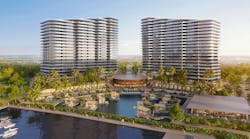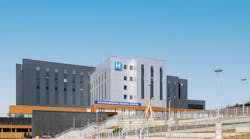Tinted Concrete And Detail Work
With building design moving in artistic directions from the vertical box look of the post World War II era, demand is growing for contractors skilled at detail work. Balfour Beatty Construction needed just such a firm to tackle construction of the one-of-a-kind architectural retaining wall system and concrete hardscape for their project, Tower IIIB for Children's Medical Center in Dallas, TX. They chose Serco Construction Group, Ltd. of Dallas.
SERCO Construction Group, Ltd. is a privately held MBE and HUB-certified firm that specializes in structural concrete and earthwork. Partners Dr. Serge P. François and Gary L. Conaway, P.E. started the company in 2003.
Colored Retaining Walls
The retaining walls are stair-cased upward and backfilled to create a hill where there was none before. Because Balfour Beatty constructed the hospital tower from street elevation, backfill covers the first floor; in essence, the first floor is now a basement with the main entry at the second floor.
The retaining walls presented challenges, like themselves, on different levels. The design called for both a randomly recurring “fractured fin” wave pattern formed directly into the colored concrete, as well as a curvilinear layout for the walls, which in one area stand 25 feet tall.
Serco's challenge involved fabricating and installing the fractured fin pattern in a random pattern while maximizing the economics of reusing forms. After reviewing several specialty form liner companies, Serco selected CMC Construction Services and Fitzgerald Form Liners to design and fabricate the elastomeric custom-designed form liners. Together, the team recommended a randomly repeating form liner pattern by alternating panels that met the architect's design.
“Re-use and alternating the panels was key to providing a system that was economically feasible to construct in the field,” explained Ron Smith, Serco project manager.
The Serco field team, led by Leon Hunt, field constructed specialty curved walers and tie systems to ensure the wall was installed on the proper curvilinear pattern and was structurally sound in order to support the placement of the colored concrete system.
The thickness of the walls was dictated by their height. Thicknesses range from 1 foot thick to 2.5 feet thick at the base of the taller walls. CMC Lofland supplied the No. 6 and No. 8 reinforcing steel.
“We had four panels – A, B, C, and D – in order to get the curvilinear effect,” explained Ronald Smith, project manager “We went A, B, C, and D, and then we reversed it so that the A was upside down and the design flows all the way through the project. We used 20 sections to create this [wall pattern].”
“That was part of the difficulty,” said Gary Conaway, P.E. senior vice president, “trying to create a pattern that doesn't appear to repeat, yet not buying an individual panel for every section of the wall.”
Rosemary tint is an integral color manufactured by Solomon Bros. It was mixed throughout into the concrete by supplier Southern Star.
Finish-out will involve sandblasting in between the fractured bands and landscaping.
Structural backfill was brought in early in the project along with installation of the mechanical equipment pads inside the building.
“There is between 15 to 20 feet of relief from street level to the main entry of the building,” commented Ron Smith. “The height was physically created with the walls and backfilling to give it a tiered look, which is very unique for Dallas's flat landscape.”
Atop this man-made hill at the main entrance, Serco crews prepared to pave the entrance drive. A section of paving for the hospital entrance will also be tinted with the rosemary color. A pavement flatwork will transition to a section of rawhide color at the main entry with black charcoal onyx-colored concrete as an accent. The curbs will have ballards set in them with matching-colored paving.
Garden Environment
In the Children's Medical Center garden, hardscape elements will include a waterfall and meandering stream fashioned by Serco workers, and a meditation labyrinth to be fabricated by Labyrinth Enterprises of St. Louis, MO. Final garden plans are still in design.
|

